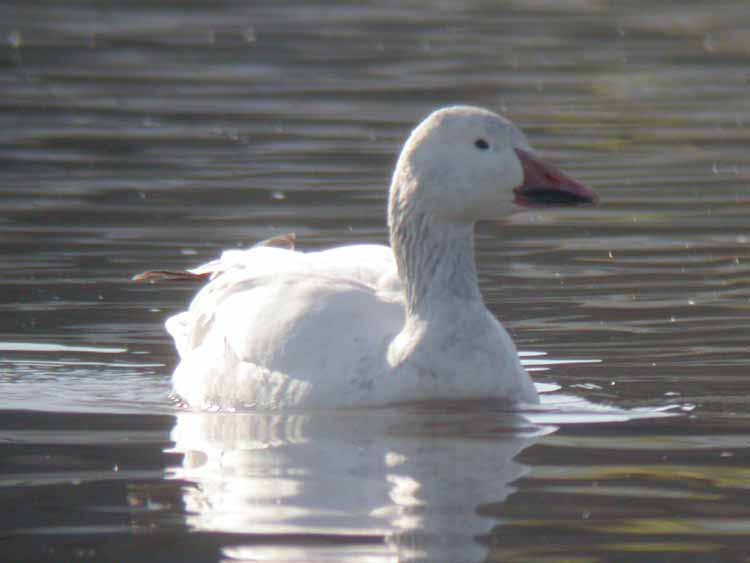Snow Goose Anser caerulescens
Formerly Chen rossii. Snow Geese are popular in captivity and escapes occur frequently. However genuinely wild birds do occur occasionally and in Norfolk these are most likely to be found among the wintering Pink-footed Goose flocks (though one accompanied Whooper Swans a few years ago). They are rare though, and the earliest of the Norfolk birds shown below followed a gap of several years.
The majority of Snow Geese occurring in the UK are thought to be Greater Snow Geese A. c. atlantica but smaller individuals are sometimes attributed to the more westerly originating nominate form, Lesser Snow Goose A. c. caerulescens.
The first bird shown below is small and is believed to be a Lesser Snow Goose, though both forms vary in size and I'm not sure how possible it is to be 100% sure.
 L.JPG)
 L.JPG)
Lesser Snow Goose (with Pink-footed Geese), between Brancaster Staithe and Stanhoe (Norfolk, UK), 17th October 2006
The following young bird remained with the Pink-feet until 7th May when it was seen departing to the north. The same day it was seen passing several sites in Yorkshire before ending up in Northumberland, 170 miles north-west, by early evening.
 L.JPG)
first-winter Snow Goose (with Pink-footed Geese), Holkham (Norfolk, UK), 22nd January 2005
Blue (and/or intermediate) morph Snow Geese are particularly rare here and the individual shown here was possibly the first such wild bird to be seen in Norfolk, apart from a bird of unknown origin with Taiga Bean Geese in the winter of 1973/74. Most blue morph Snow Geese are Lesser Snow Geese and the small size of this individual supports that identification.
 L.JPG)
 L.JPG)
blue (or intermediate) Snow Goose (with Pink-footed Geese), south of Brancaster (Norfolk, UK), 6th October 2006
This bird, and the white one shown further up this page, spent several weeks among the 100,000+ Pink-footed Geese in Norfolk before finding each other. By the time the following photo was taken the two birds were normally seen in each other's company.
 L.JPG)
Blue (or intermediate) Snow Goose (with Pink-footed Geese), south of Brancaster (Norfolk, UK), 30th November 2006
 L.JPG)
 L.JPG)
Snow Goose (with Pink-footed Geese), Choseley (Norfolk, UK), 4th December 2007
This individual was keeping company with feral geese and was widely assumed to be an escaped bird.
 L.JPG)
 L.JPG)
presumed escaped Snow Goose, Stiffkey Fen (Norfolk, UK), 21st March 2009
Perhaps the same bird, and with one or two having spent the whole summer in the area, again assumed to be escaped.
 L.JPG)
 L.JPG)
presumed escaped Snow Goose (with Canada Geese), Salthouse (Norfolk, UK), 28th October 2009
 (2) L.JPG)
 (1) L.JPG)
 (3) L.JPG)
 (4) L.JPG)
blue and white Snow Geese, Tayinloan (Argyll & Bute, UK), 4th February 2010

second calendar-year Snow Goose, Robert's Lake, Seaside (California, UK), 4th February 2010
Having not previously noticed how orange the base of a Snow Goose's bill can look I considered whether these captive birds could be hybrids, but quickly discounted that as they showed no other sign of impurity. Further investigation revealed that it's not so unusual for a pure Snow Goose to show orangey tones at the base of the bill.
 L.JPG)
 L.JPG)
 L.JPG)
 L.JPG)
 L.JPG)
 L.JPG)
 L.JPG)
 L.JPG)
 L.JPG)
 L.JPG)
 L.JPG)
 L.JPG)
 L.JPG)
 L.JPG)
two adult and one first-winter captive Snow Geese (with Bar-headed Goose), Grange-over-Sands (Cumbria, UK), 28th December 2011
 L.JPG)
 L.JPG)
adult and first-winter captive Snow Geese, Grange-over-Sands (Cumbria, UK), 27th December 2012
 L.JPG)
Snow Goose (with Pink-footed Geese), between Brancaster Staithe and Docking (Norfolk, UK), 4th February 2010
 L.JPG)
Snow Goose (with Pink-footed Geese), north of Docking (Norfolk, UK), 21st October 2009
